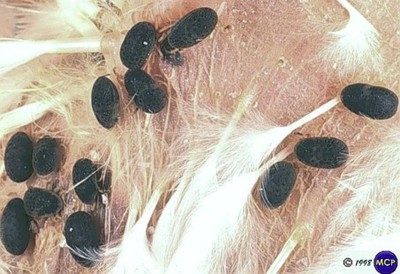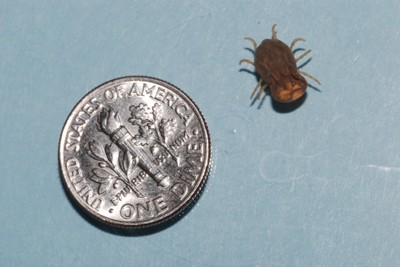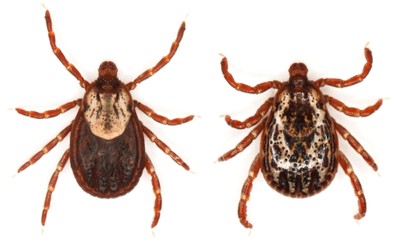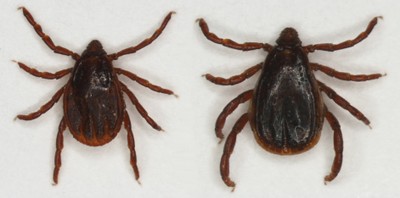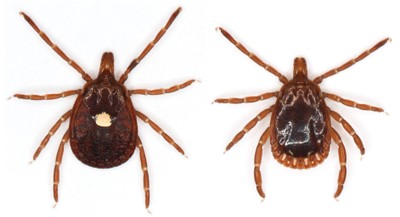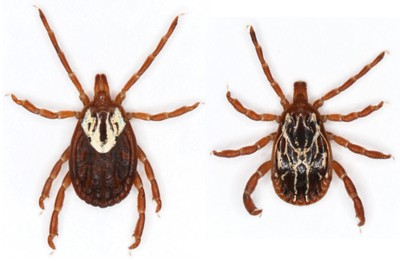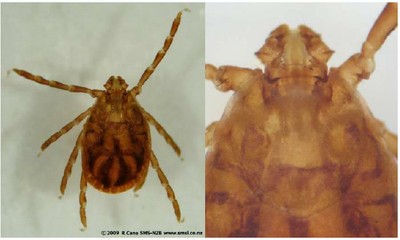Ticks
Soft Ticks (Argasidae)
- Fowl Tick [Argas persicus (Oken)]
The fowl tick or “blue bug” can be a very important poultry parasite. The tick can cause weight loss, blemishes, and lower egg production.
All life cycles feed on the same type of host, and the life cycle is completed fairly quickly. Large populations are capable of killing birds or chicks through blood loss. The female lays her eggs, which can be 25 to 100 at a time, in cracks and crevices. The larva feed for 4-5 days before completing that stage of development and molting into the nymphal stage. The nymphs feed at night, requiring several feeding before reaching the adult stage. The adults feed mostly at night, hiding around roosting areas during the day.
The fowl tick has the ability to go without feeding for extended periods of time, therefore, simply leaving poultry facilities vacant for long periods of time will not be very effective in eliminating the pest population. Thorough spray applications can help control the ticks, but the best control is sanitation.
- Spinose Ear Tick [Otobius megnini (Duges)]
Spinose Ear Tick (Otobius megnini) nymph.
Credit: D. Kattes Tarleton State University
The Spinose ear tick is a common parasite of a wide variety of both wild and domestic hosts including cattle, and horses. This tick is found in the ear canals of the host. Large numbers can cause irritation, inflammation, and even deafness. Secondary bacterial infections can develop and cause sloughing of the ear tissue. Infested cattle will develop a “flop-eared” condition which causes discomfort when moving the head.
The larva and nymphs are blood feeders, yet the adult stage is not. The larva stage become active in March. The nymph is recognizable by the spines on the outside covering and the peanut shape of the body. The nymph will feed multiple times over a 30 to 200 day period. After the last feeding the nymph falls to the ground, and molts into an adult. The adults are active in low light and the primary reason is to mate. The females lay their eggs around feed bunks and boards. The larva then hatch and climb to higher structure to find a host.
The best control for Spinose ear tick is the use of insecticide ear tags.
Hard Ticks (Ixodidae)
- Black-legged Tick [Ixodes scapularis (Say)]
Deer tick or Black-legged tick (Ixodes scapularis) female (L) male (R).
Credit: R. Grantham Oklahoma State University
The black-legged tick (often called the “deer tick”) does not have colorful markings and is a three-host tick. It is an important pest of livestock and wildlife in Oklahoma. This tick is a vector of the intracellular bacteria that causes human granulocytic anaplasmosis (Anaplasma phagocytophilum). In addition, this tick transmits several protozoan pathogens to humans, rodents and deer (Babesia microti, Babesia odocoilei), and the Lyme disease spirochete (Borrelia burgdorferi) to humans, dogs, cattle and rodents.
The adults become active in late September and October and are present until March or April. During the early fall, it is often the most common tick on deer and cattle in Oklahoma. The larvae and nymphs are active in the spring and summer and feed on snakes and lizards. In Oklahoma, the black-legged tick is not known to transmit Lyme disease, because the larval ticks do not feed on mice that serve as reservoir hosts for the bacteria.
- Winter Tick [Dermacentor albipictus (Packard)]
Winter Tick (Dermacentor albipictus) female (L) male (R).
Credit: Univ. of Georgia
The winter tick is an important pest of horses, cattle, deer and elk in Oklahoma. Coloration of the dorsal shield varies from none to almost complete covering with white. It is the only one-host hard tick in Oklahoma, spending its entire life cycle on one host. Heavily infested range animals may be killed due to blood loss if left untreated. The winter tick is a vector of anaplasmosis in cattle.
The larval stage becomes active in early October, and the nymphs and adults are most active during the late fall, winter and early spring. Females lay eggs on the ground after feeding, and then, die. The eggs may hatch in three to six weeks if temperatures remain above 50 F. The larvae bunch together and remain inactive until the onset of cool weather the next fall. This is a very large tick when engorged and very noticeable on animals.
- American Dog Tick [Dermacentor variabilis (Say)]
American Dog Tick (Dermacentor variabilis) female (L) male (R).
Credit: R. Grantham Oklahoma State University
The American dog tick is a common pest of dogs and other small, wild or domestic animals, which are the preferred hosts for the adults of this species. This is a colorful species, having spots of light colors (white, gray, silver) scattered and superimposed over the basic brown and black body color. The American dog tick is a three-host tick. The adults sometimes infest large animals including horses and cattle, but are seldom serious pests of these animals. The adults often blood feed on humans, and they are a serious pest in high-use wooded recreational areas. The larvae and nymphs feed on small rodents (e.g. mice, rats and rabbits).
The American dog tick is the only known vector of Rocky Mountain spotted fever (RMSF, Rickettsia rickettsii) in Oklahoma. This tick is also a vector of bovine anaplasmosis (Anaplasma marginale), feline cytauxzoonosis (cats, Cytauxzoon felis), canine monocytic ehrlichiosis (dogs, Ehrlichia canis) and human monocytic ehrlichiosis (HME, Ehrlichia chaffeensis). It is also known to cause tick paralysis in people and dogs.
The larval and nymphal stages have been known to survive two years or longer without feeding. Under suitable conditions, the life cycle from egg to adult may require only three months, but usually the life cycle requires at least one year.
- Brown Dog Tick [Rhipicephalus sanguineus (Latreille)]
Brown Dog Tick (Rhipicephalus sanguineus) female (L) male (R).
Credit: R. Grantham Oklahoma State University
The brown dog tick is probably the most widely distributed tick species in the world and is very common in Oklahoma. Dogs are the primary host, but when dogs and their bedding places are in close association with humans, bites to people become more frequent. It is a three-host tick, but all stages feed on dogs.
The adult ticks are most often found in the ears and between the toes of dogs. The larvae and nymphs are found in the long hair on the back of the neck. The eggs are deposited in cracks and crevices of the dog kennel. These ticks have a tendency to crawl upward and are commonly found in cracks in the roof of dog kennels or ceilings of porches. These ticks will also become established in houses and other buildings that are inhabited by dogs. The brown dog tick transmits a wide range of pathogens to dogs that include Anaplasma platys, Babesia canis, Babesia gibsoni, Ehrlichia canis, Hepatozoon canis and Rickettsia rickettsii.
- Lone Star Tick [Amblyomma americanum (L.)]
Lone Star Tick (Amblyomma americanum) female (L) male (R).
Credit: R. Grantham Oklahoma State University
The lone star tick is a three-host tick and is an important pest of all livestock and wildlife. Larvae, nymphs and adult stages of this species readily feed on humans. This is probably the tick most commonly encountered by people during recreational activities in Oklahoma. Ticks quest for hosts along trails and pathways. The larval lone star tick will infest more than 40 different species of wild and domestic birds.
The tick receives its name for the lone white spot on the dorsal shield of the female. The male has white markings around its posterior margin. This species has longer mouthparts than the tick species previously discussed.
The lone star tick is active from early spring to late fall. The female is capable of laying 9,000-12,000 eggs. This species is one of the most important ticks from a public health standpoint. It is known to transmit human monocytic ehrlichiosis (Ehrlichia chaffeensis), STARI (southern tick-associated rash illness), canine granulocytic ehrlichiosis (Ehrlichia canis), tularemia (Francisella tularensis), Heartland virus, and a Spotted fever type of disease (Rickettsia amblyommii is likely to be the cause).
- Gulf Coast Tick [Amblyomma maculatum (Koch)]
Gulf Coast Tick (Amblyomma maculatum) female (L) male (R).
Credit: R. Grantham Oklahoma State University
This is a three-host tick. As larva and nymph, the Gulf Coast tick is a common pest of ground-inhabiting birds, such as meadowlarks and bobwhite quail, or small rodents. The adults primarily blood feed on cattle, but a variety of other hosts including dog, horse, sheep, deer, coyote and humans can be parasitized. This tick has become increasingly abundant in Oklahoma in the last 20 years and is an important pest of cattle. In addition, the gulf coast tick transmits Hepatozoon americanum to dogs and coyotes and possibly, Rickettsia parkeri to humans. The adults attach to the ears of cattle and are most abundant in early April to mid-June. When infestations are high on cattle, the ears may become thickened and curled causing a condition called “gotch ear.” This tick reportedly has produced tick paralysis in humans and dogs.
Longhorned Tick (Haemaphysalis longicornis)
The above pictures were taken in the Spring of 2016 by the Livestock Entomology Lab. This group of replacement heifers had a intensive infestation of the Gulf Coast tick. The Herd Managers were alerted to the infestation when the cattle started exhibiting signs of "Gotch Ear" and were bleeding from their ears. The Livestock Entomology Lab sprayed the heifers ears and back with a Permethrin spray and monitored the herd for signs of re-infestation. To see a demonstration of the proper way to spray for ear ticks, view these videos.

